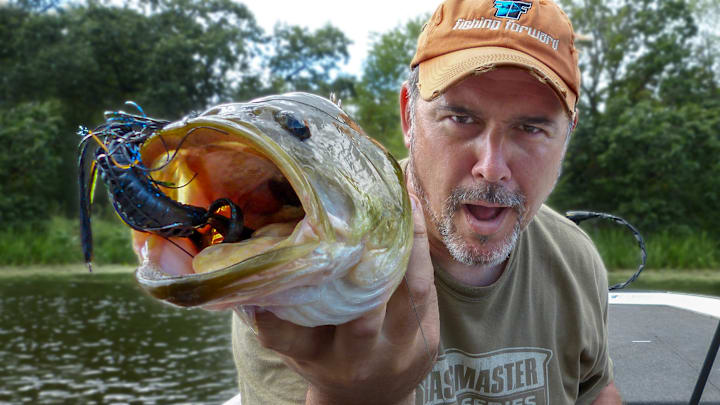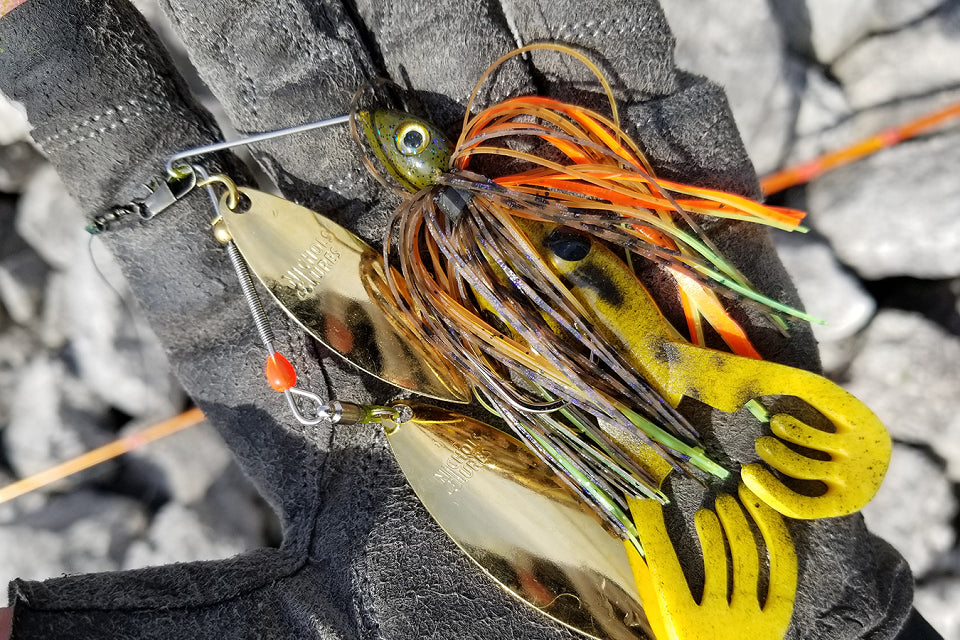Top-Rated Best Bass Fishing Lures That Actually Work Year-Round
Discover the most effective Techniques for Choosing Bass Lures for Your Following Fishing Expedition
Selecting the ideal bass Lures can significantly impact angling success. Anglers need to take into consideration numerous variables, such as seasonal patterns and water quality. Understanding bass behavior is vital (Bass Fishing Lures). Selecting Lures that simulate natural target can cause better results. Yet, several are uncertain concerning the most effective methods to implement. What methods should one prioritize to enhance their angling experience? The responses lie in checking out particular conditions and adjusting accordingly
Comprehending Bass Habits and Environment
Recognizing the nuances of bass habits and environment is crucial for any kind of angler aiming to enhance their fishing success. Bass are commonly found in various environments, consisting of rivers, lakes, and reservoirs, where they seek structure such as immersed rocks, plant life, and dropped trees. Their habits is greatly affected by water temperature level, light degrees, and available forage.
Throughout warmer months, bass often tend to be a lot more energetic, typically populating shallower waters, while in colder months, they retreat to much deeper locations. Additionally, bass display patterns of feeding, usually being a lot more aggressive throughout dawn and sundown. They are opportunistic killers, taking advantage of smaller fish, insects, and shellfishes. Comprehending these aspects can assist anglers identify prime fishing locations, along with the very best times to fish. Acknowledging bass habits in regard to their habitat is important for successful angling, leading anglers in making informed decisions about where to cast their lines.
Matching Lures to Seasonal Issues
As anglers adjust their strategies to altering seasons, matching Lures to seasonal conditions becomes a vital strategy for enhancing angling success. In spring, when bass are arising from winter season dormancy, fishermens usually utilize spinnerbaits and shallow-running crankbaits to imitate the motions of victim. Summertime demands a shift to topwater Lures or soft plastic worms, as bass look for shade and cooler waters. Throughout the fall, when bass are fattening up prior to winter, larger Lures that imitate baitfish can be effective. Wintertime calls for a more subtle method; jigs and slow-moving finesse lures usually produce far better outcomes as bass end up being lethargic. Understanding these seasonal patterns assists anglers pick the ideal lures, thereby raising their opportunities of a successful catch. By straightening lure selections with the natural habits of bass throughout the year, fishermens can maximize their fishing experience and enhance their total success on the water.
The Significance of Color Option
Shade option plays a vital duty in bass fishing, as it can dramatically impact a fisher's success. Variables such as water quality, seasonal modifications, and the particular preferences of different bass species all affect which colors are most reliable. Understanding these elements allows fishermens to make enlightened choices that enhance their angling experience.
Water Clearness Considerations
When the water clarity differs, picking the right bass lure shade ends up being important for attracting fish. In clear water, natural shades such as shad or bluegill patterns tend to be much more efficient, as they imitate the target bass are accustomed to seeing. On the other hand, in dirty or tarnished water, brighter shades like chartreuse or fire tiger can boost presence, making it simpler for bass to detect the attraction. The contrast between the appeal and the surrounding setting plays a considerable duty in angling success. Anglers should likewise take into consideration the moment of day; lighter shades might work much better in intense sunlight, while darker colors can be more effective throughout low-light conditions. Adapting appeal color to water clarity optimizes the chances of a successful catch.
Seasonal Shade Patterns
Just how do seasonal changes influence bass habits and lure efficiency? As temperatures shift throughout the year, bass readjust their feeding routines and chosen environments, making color selection vital for successful angling. In springtime, when bass spawn, brilliant colors like chartreuse can bring in focus. Summer months often ask for more all-natural colors, such as eco-friendly pumpkin or shad patterns, as bass seek to assimilate with their surroundings. During autumn, vibrant colors like orange and red resemble the transforming vegetation, enticing bass as they plan for wintertime. In wintertime, subdued tones such as white or gray may be more reliable, as bass become inactive. Ultimately, comprehending seasonal color scheme allows anglers to choose Lures that reverberate with bass's current actions, enhancing their possibilities of success.

Species-Specific Preferences
Comprehending species-specific choices is vital for anglers wanting to enhance their attraction selection. Different bass species, such as largemouth and smallmouth, display special color preferences based upon their habitat and feeding behaviors. Largemouth bass typically prefer darker colors, specifically in murky waters, where colors like black and dark eco-friendly mimic all-natural prey. On the other hand, smallmouth bass are most likely to reply to brighter colors, such as chartreuse and orange, specifically in clear waters. Additionally, water quality and light conditions can affect these preferences, making it vital for anglers to adjust their attraction shade appropriately. By taking into consideration these species-specific choices, anglers can enhance their chances of a successful fishing expedition, eventually boosting their overall experience on the water.
Picking the Right Draw Kind for Different Scenarios
Picking the ideal lure type for numerous angling circumstances is crucial for success on the water. Anglers have click for source to take into consideration elements such as water clarity, weather, and the bass's feeding habits. For dirty water, darker-colored lures, such as jigs or spinnerbaits, can be reliable, as they develop a strong shape. In clear water, natural-colored Lures like soft plastics or topwater baits might attract wary bass.
When fishing in heavy cover, utilizing heavy jigs or weedless gears can help navigate through barriers without getting. Alternatively, open water circumstances may take advantage of crankbaits or swimbaits that can cover better ranges. Furthermore, during cooler months, slower-moving Lures tend to be extra reliable, while warmer conditions may require faster retrieves. By adapting lure choices to particular atmospheres, anglers enhance their possibilities of a successful catch.
Trying out Size and Action

Anglers often try out a variety of sizes and activities to determine what works best under varying conditions. A sluggish, refined activity may be excellent in chillier water, while a quick, hostile recover could be much more efficient in warmer temperature levels. By meticulously observing the bass's reactions to these variations, anglers can fine-tune their strategy and raise their opportunities of an effective catch. Inevitably, the right mix of dimension and action can make a substantial distinction on the water.
Checking Out Water Conditions for Better Lure Choices
Recognizing water problems is important for choosing the best bass appeal. Factors such as water quality and temperature can dramatically affect fish actions and feeding patterns. By assessing these problems, anglers can make informed choices that boost their chances of a successful catch.
Analyzing Water Clarity
Exactly how does water clearness affect the performance of bass appeals? Water clarity significantly influences bass actions and the exposure of appeals. In clear water, bass have a tendency to be extra mindful, making natural-colored Lures a lot more efficient as they resemble prey closely. Fishermens might pick lighter, subtler hues to stay clear of spooking fish. On the other hand, in murky or tarnished water, more vibrant and even more vivid shades stand apart, bring in focus even in low visibility problems. Furthermore, the kind of attraction can differ; slower-moving Lures could work much better in clear water, while quicker, extra aggressive discussions can attract bass in murkier atmospheres. Comprehending the clarity of the water enables fishermens to pick Lures that maximize their chances of success throughout their angling trips.
Recognizing Water Temperature
As water temperature rises and fall, it straight influences bass actions and their feeding patterns, making it essential for anglers to take into consideration when choosing appeals. Generally, bass prefer warmer temperatures, commonly between 65 ° F and 75 ° F, where their metabolism is increased, causing increased feeding task. In look at this web-site cooler water, bass become inactive and may choose slower-moving lures, such as jigs or soft plastics. Alternatively, throughout warmer months, faster presentations like crankbaits or topwater Lures can be extra efficient. Anglers need to likewise take into consideration seasonal adjustments; as an example, spring warming leads to aggressive feeding as bass prepare to spawn. By understanding just how temperature influences bass, fishermens can make enlightened choices on attraction option, significantly boosting their chances of other success.
Tips for Organizing and Maintaining Your Lure Collection
While several fishermens concentrate on picking the ideal Lures for their next fishing expedition, preserving an appeal and arranging collection is similarly crucial for boosting effectiveness and performance. A well-structured collection permits anglers to swiftly locate the Lures they require, lowering time spent searching with deal with boxes.
To begin, fishermens ought to classify Lures by kind-- crankbaits, jigs, or soft plastics-- making it much easier to locate particular alternatives. Making use of tackle trays or boxes with adjustable compartments can help maintain every little thing arranged. Classifying containers simplifies the process additionally, aiding fast recognition.
Normal upkeep is likewise essential; fishermens ought to inspect Lures for signs of wear, such as rusted hooks or damaged paint, and change them as required. Cleaning Lures after each journey prevents degeneration and guarantees durability. By applying these organizational and upkeep methods, anglers can boost their fishing experience and ensure their Lures are always in ideal problem.
Regularly Asked Inquiries
What Are the Finest Brand Names for Bass Lures?
The finest brand names for bass Lures include Rapala, Strike King, and Berkley. These brands are renowned for their advancement, quality, and effectiveness, attracting both amateur and experienced anglers seeking effective angling experiences.
The Number Of Lures Should I Handle a Journey?
A normal fishing trip need to consist of around 5 to ten appeals, enabling convenience while avoiding clutter. This selection must include various kinds and shades to adapt to changing problems and fish preferences.
Can I Make My Very Own Bass Lures?
Yes, individuals can make their very own bass Lures using various products and methods - Bass Fishing Lures. Crafting Lures permits for modification, making it possible for fishermens to explore shapes, sizes, and colors to suit certain angling conditions and preferences
What's the Average Life Expectancy of a Bass Draw?
The typical life-span of a bass lure differs, generally lasting from a few months to numerous years, relying on material top quality, use regularity, and ecological conditions. Appropriate treatment can considerably expand a lure's usability.
Exist Specific Lures for Evening Angling?
Yes, there are specific Lures made for night angling. Dark shades and Lures that generate resonances, such as spinnerbaits or jigs, commonly attract bass in low-light problems, boosting presence and causing predacious reactions.
Conversely, in dirty or stained water, brighter colors like chartreuse or fire tiger can improve exposure, making it less complicated for bass to find the attraction. Bigger Lures can attract bigger bass, while smaller sized Lures might be much more efficient for capturing smaller fish. Furthermore, the type of appeal can differ; slower-moving Lures could work much better in clear water, while much faster, a lot more hostile discussions can attract bass in murkier environments. As water temperature changes, it straight affects bass actions and their feeding patterns, making it crucial for fishermens to take into consideration when selecting attractions. While many anglers focus on selecting the ideal Lures for their next fishing trip, preserving a lure and organizing collection is equally vital for improving performance and efficiency.